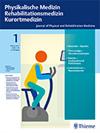Effects Of Decompression Surgery On Pelvic Movements In Patients With Degenerative Lumbar Stenosis
IF 0.5
4区 医学
Q4 REHABILITATION
Physikalische Medizin Rehabilitationsmedizin Kurortmedizin
Pub Date : 2023-02-15
DOI:10.1055/a-2121-3402
引用次数: 0
Abstract
Abstract Objective Pelvic movements when walking should be objectively evaluated in the context of clinical data in order to understand the function of compensatory mechanisms in the onset and management of symptomatic degenerative lumbar stenosis (DLS). The purpose of this study was to compare patients treated with decompression surgery (DS) and patients with symptomatic DLS in terms of pelvic movements while walking. Materials and Methods A total of 107 participants were included in this study. 34 patients who underwent DS performed by the same surgeon were selected as the DS group, while 39 patients with DLS who required surgery were selected as the DLS group. The control group consisted of 34 age-matched healthy individuals who had no disease and no gait disorder. The BTS G-WALK sensor system (G-Walk) was used to measure pelvic movements (tilt, rotation, obliquity) and gait parameters (speed, cadence, stride length). Results DS and control groups had decreased maximum (p=0.008 and p=0.006, respectively) and minimum anterior tilt of the pelvis (p=0.015 and p=0.001, respectively) compared to the DLS group. There was no significant difference between the groups for rotation, oblique and tilt range of motion of the pelvis (p>0.05). Compared to the control group, speed during gait were significantly lower in both the DLS (p=0.012) and DS groups (p=0.016). Conclusions In this study, decompression surgery was found to affect pelvic movements. Patients with DLS walked differently from those who had no symptoms, and this difference usually disappeared following surgical decompression. Pelvic movements may serve as a helpful screening measure to identify early compensatory mechanisms. Key words: lumbar stenosis, pelvic movement, decompression surgery, spine-pelvis lower extremity, sagittal alignment减压手术对退行性腰椎管狭窄患者骨盆运动的影响
【摘要】目的为了了解代偿机制在症状性退行性腰椎管狭窄症(DLS)发病和治疗中的作用,应结合临床资料客观评价行走时骨盆运动。本研究的目的是比较减压手术(DS)患者和有症状的DLS患者在行走时骨盆运动方面的差异。材料与方法本研究共纳入107名受试者。选择34例由同一术者行DS的患者为DS组,39例需要手术的DLS患者为DLS组。对照组由34名年龄匹配的健康个体组成,他们没有疾病,也没有步态障碍。采用BTS G-WALK传感器系统(G-WALK)测量骨盆运动(倾斜、旋转、倾斜)和步态参数(速度、节奏、步幅)。结果与DLS组相比,DS组和对照组骨盆前倾最大值(p=0.008和p=0.006)和最小值(p=0.015和p=0.001)均降低。两组间骨盆旋转、倾斜、倾斜活动度差异无统计学意义(p < 0.05)。与对照组相比,DLS组(p=0.012)和DS组(p=0.016)的步态速度明显降低。结论本研究发现减压手术会影响骨盆运动。DLS患者与无症状患者行走方式不同,这种差异通常在手术减压后消失。盆腔运动可以作为一个有用的筛查措施,以确定早期代偿机制。关键词:腰椎管狭窄症,骨盆运动,减压手术,脊柱-骨盆下肢,矢状位对齐
本文章由计算机程序翻译,如有差异,请以英文原文为准。
求助全文
约1分钟内获得全文
求助全文
来源期刊
CiteScore
1.10
自引率
25.00%
发文量
70
审稿时长
3 months
期刊介绍:
The Journal of Physical and Rehabilitation Medicine offers you the most up-to-date information about physical medicine in clinic and practice, as well as interdisciplinary information about rehabilitation medicine and spa medicine.
Publishing 6 issues a year, the journal includes selected original research articles and reviews as well as guidelines and summaries of the latest research findings. The journal also publishes society news and editorial material. “Online first” publication ensures rapid dissemination of knowledge.

 求助内容:
求助内容: 应助结果提醒方式:
应助结果提醒方式:


